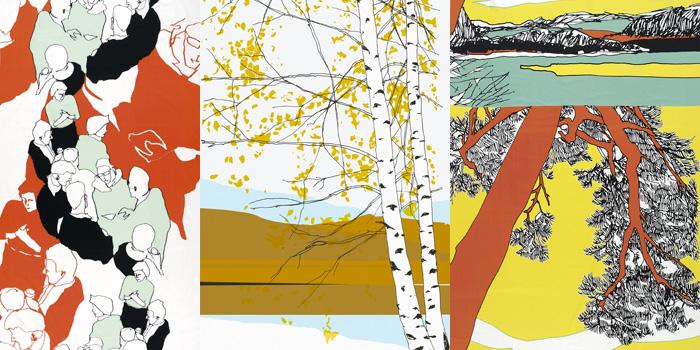
Other areas /
Google Ads
Maija Louekaris: Channeling a spiritWhen Maija Louekaris won a design competition held by Finnish fabric magnate Marimekko, it was a textile designer's dream come true. |
SUBSCRIBE SEND AS EMAIL |

|
|
|
Maija Louekaris's designs Hohoi, Kaiku, Ystavat
|
1 |
|
A graduate student at the time, Louekaris was searching for a way to combine the interior design education she had previously gained with her talent for drawing. "Textile design really took me by surprise," Louekaris said. "I became a textile designer by accident, because I got offered a job at Marimekko after I won the competition."
Since then, Louekaris has never looked back. She has consistently produced striking designs characterized by vibrant color combinations and expressive motifs. Louekaris typically depicts the modernist mayhem of the urban centre - as captured in prints such as 'Hetkiä' and 'Ystävät' - or portrays tranquil settings in the natural world - such as 'Kaiku' and 'Ho-hoi'. "Cities inspire me with their energy, the people, buildings, events, and phenomena," Louekaris said. "Cities are multilayered and multi-dimensional: They function as entities but yet come alive through the power of individuals. And they are related to nature too, because they are the 'nests' of people." When it comes to her representations of nature, Louekaris regards them to be a continuation of Marimekko’s distinctive style. "Marimekko has always been a portrayer of nature, so I wanted to design my own versions of nature motifs," she said. "The purpose of a natural motif is to bring a view of the landscape into a domestic space." Although Louekaris derives inspiration from observing her surroundings, in some ways she works in isolation, focusing more on channeling the ‘Marimekko spirit’ rather than following textile trends emerging in other parts of the world. "Marimekko has such a strong and great history that it seems like a movement in itself," she said. "In my work I try to create only my own signature rather than following what’s happening elsewhere in the textile industry." In addition to cityscapes and representations of nature, Louekaris also designs geometric repeats and figurative motifs. Rather than differentiate between them, Louekaris tends to regard both expressions as a single abstract style. "It may be possible to find references to something figurative in the geometric patterns I create," she explained, "because one can find points that open up the world of the pattern. Many buyers regard geometric patterns as an easy solution for the interior decoration, and abstract styles give the viewers the freedom to interpret the design in the way that they want to." While she remains committed to the Marimekko ethos and her talent for interpreting her surroundings through textile design, neither is a driving force for Louekaris. "The most important thing is to work with love," she said. "It shows if love is present or not. It’s wonderful to be able to share something of myself with others through my fabrics. My own work seems a bit like little children being sent out into the wide 04p_orld." |
Other articles on Design / Nordic Design Now Scandinavian design: Beyond Blond Louise Campbell: If it works in paper… Driving fashion forward Design in Sports Mathias Bengtsson: Redefining boundaries Trine Andersen: Wallpaper, contemporary walls Johan Verde: Design to lift, angle, clean and store Johan Carpner: To capture the untamable Nina Jobs: Impressions of depth
|
800 827 9333 © Copyright Nordic Reach 2008